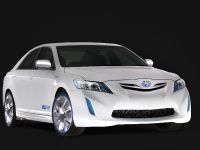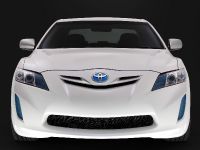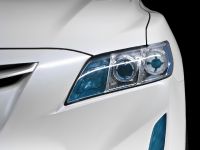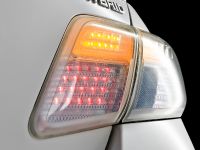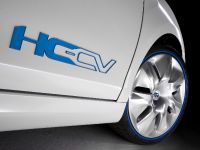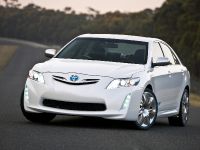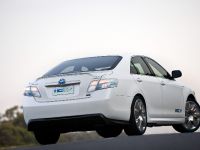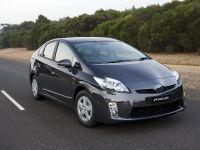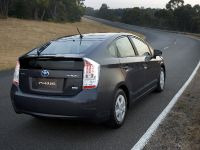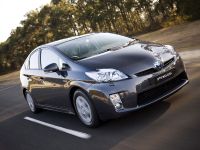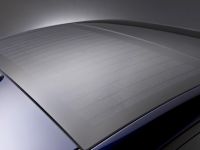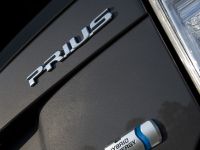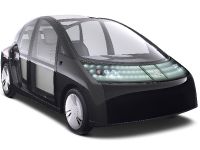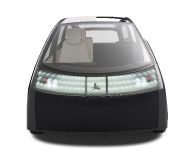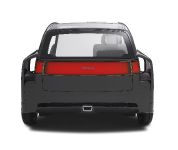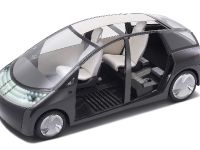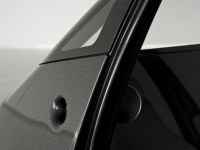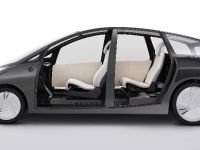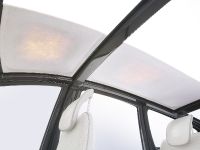Toyota Presents Three Visions for 21st Century Motoring
Australian motorists have been given a glimpse of the future of motoring with today's unveiling of three hybrid vehicles by Toyota. The vehicles - the first of which will go on sale in Australia as early as July - emphatically confirm Toyota's long-term commitment to producing hybrid vehicles that deliver superior fuel economy and ultra-low emissions.
Powered by Toyota's proven Hybrid Synergy Drive technology, they are the first vehicles to be unveiled for this week's Melbourne International Motor Show.
Toyota is showcasing the all-new third-generation Prius (to be launched in Australia in less than five months), a dramatic locally styled Hybrid Camry Concept Vehicle, and the futuristic 1/X (pronounced one-Xth) show car.
The company's senior executive director sales and marketing David Buttner said the vehicles reveal Toyota's determination to make sustainable mobility a reality.
"The three Toyota hybrid cars unveiled today contain ground-breaking technologies and highlight innovative possibilities for the future of motoring," Mr Buttner said.
"The Hybrid Camry Concept Vehicle was conceived and produced in-house by Toyota Style Australia.
"It is a strong pointer to the hybrid Camry we will manufacture right here in Australia from early next year.
"Its startling paintwork, dramatic lines and sporty appearance definitely convey the passion in our company to produce Australia's first hybrid car."
Mr Buttner said all-new third-generation Prius is the culmination of experience gained by Toyota from selling more than 1.2 million Prius globally over more than a decade.
"The third-generation Prius is a quantum leap in technology that includes a remarkable double: improved performance while using less fuel," he said.
The distinctive 1/X represents a vision for hybrid motoring in the future.
"The 1/X concept is a vehicle that completely redefines what it means to be environmentally considerate.
"The name says it all: a car that weighs a fraction of others in its class today - and uses a fraction of the fuel," he said.
The hybrid vehicles are joined on the Toyota stand by two wild-looking custom cars - a Yaris hatch and a RAV4 SUV - and 12 production vehicles.
Toyota concept vehicles at the Melbourne International Motor Show: 1. Hybrid Camry Concept Vehicle - a pointer to local hybrid manufacturing 2. All-new Prius - the third generation with more power while using less fuel 3. 1/X - a redefinition of "environmentally considerate"
Modified Toyota vehicles at the show: • Auto Salon Yaris • Auto Salon RAV4
Toyota production vehicles at the show:
- Camry Grande - Camry Sportivo - Aurion Presara - Aurion Sportivo - Corolla Levin ZR hatch - Corolla Ultima sedan - Yaris YRX 5-door hatch - RAV V6 ZR6 - HiLux SR5 4x4 turbo-diesel - Kluger Grande AWD - LandCruiser Prado Grande turbo-diesel - LandCruiser Sahara turbo-diesel
TOYOTA HINTS AT ITS LOCAL HYBRID FUTURE
Toyota Australia has celebrated winning the right to manufacture a hybrid car in Australia by producing a stylish concept car.
Developed locally by Toyota Style Australia, the HC-CV (Hybrid Camry Concept Vehicle) had its world premiere ahead of the 2009 Melbourne International Motor Show.
The unveiling of the concept car marks the start of a 12-month countdown to the launch of Australia's first locally produced hybrid car, based on the best-selling Camry sedan.
Toyota Australia president and chief executive officer Max Yasuda said the concept car was the most important vehicle on the company's motor show stand.
"The startling paintwork, dramatic lines and sporty appearance of this concept car convey the excitement and passion in our company to produce Australia's first hybrid car," Mr Yasuda said.
"The hybrid Camry - which will share some key design features with the HC-CV - will play a key role in bringing the future to the Australian automotive manufacturing sector.
"It is a future that uses less fuel while delivering better performance."
The hybrid Camry uses a four-cylinder petrol engine linked to a powerful electric motor.
It produces more power than a conventional petrol-engine vehicle while delivering better fuel economy.
Mr Yasuda said many industry commentators were urging carmakers to produce more fuel-efficient cars.
"Toyota is already the only local manufacturer producing a four-cylinder car in this country. We have been building Camry in this country - in Melbourne - for nearly 22 years.
"It's been Australia's best-selling medium car for 15 years - and it's our leading automotive export.
"Toyota also produces the most fuel-efficient Australian-made large six-cylinder sedan, the Aurion, in Melbourne.
"Our locally manufactured hybrid Camry will be launched early next year."
Contemporary hybrid design
Toyota Style Australia corporate manager Paul Beranger said Toyota has evolved the styling of its hybrid vehicles since the late 1990s.
"HC-CV is our expression of the contemporary hybrid sedan," he said.
The front of the car is characterised by expressive, sharp lines and taught surfaces. It echoes the latest Toyota Hybrid styling cues, with vertical fog lamps, larger lower opening and a streamlined upper grille.
"The crisp corners indicate aerodynamic efficiency, while the overall styling feel is efficient, yet dynamic," Mr Beranger said.
"The lower grille texture is a random pattern, inspired by forms found in nature, moving away from traditional constructed patterns," he said.
The "aero" theme continues along the side skirts, which flow into the rear diffuser, giving a sporty, yet lightweight and functional appearance. The rear spoiler enhances the visual appeal.
The headlights are symbolic of Toyota's hybrid image with a blue hue. They fuse technical elements with natural forms. Some lenses have a waterfall impression, while others are functional, lightweight and technical in appearance. The rear LED lamps, also with a blue hue, provide an unmistakable hybrid look.
Toyota logos on the car are also highlighted by a translucent blue hue. The satin chrome front grille, mirrors and rear boot-lid garnish add to the clean, crisp image.
The wheels are a combination of shear, overlayed surfaces and graphics.
The body colour is unique - a satin white pearl with subtle blue highlights to provide a serene, calm feeling. The paint allows intricate detailing and features to show through.
The interior uses contrasting coloured trim. Highlights of metallic blue have been applied asymmetrically to the seats in a wave-like graphic reminiscent of the Hybrid Synergy Drive logo.
The seat embossing echoes the exterior grille mesh with a tree bark-like pattern. White stitching adds a subtle, yet premium touch. Satin chrome accents tie in with the exterior and add to the tranquil environment.
NEW PRIUS ADOPTS WORLD AND TOYOTA FIRSTS
Toyota's next-generation Prius will be the first car sold in Australia to cut CO2 emissions to below 100 grams per kilometre.
Due in Australia in July, the third-generation of Toyota's iconic petrol-electric hybrid car also introduces several world and Toyota firsts.
Toyota Australia senior executive director sales and marketing David Buttner said the upcoming Prius - on display at the Melbourne International Motor Show - is the finest example yet of Toyota's Hybrid Synergy Drive technology.
"The next-generation Prius brings a quantum leap in technology with a remarkable double - improved performance and better fuel economy," he said.
"We expect power gains of at least 20 per cent and significantly improved torque characteristics, at the same time as cutting fuel use by approximately 10 per cent.
"As a result, Prius owners will enjoy greater driving pleasure while having less impact on the environment.
"Acceleration will be punchier and highway cruising more relaxed, and yet Toyota's internal testing shows it will emit fewer than 100 grams of CO2 per kilometre.
"That is impressive from a full-size car with a 1.8-litre petrol engine that seats five adults in comfort and swallows their luggage."
Mr Buttner said Prius is the uncompromised hybrid.
"There's nothing 'micro' or 'mild' about its technology - or its size and performance," he said.
The Hybrid Synergy Drive system in the third-generation Prius is 90 per cent newly developed with significant improvements.
It's smarter, lighter and more efficient with a new electronically controlled system for recovering energy from braking.
It offers three driving modes - electric only, eco and power - so that you can get the best possible fuel economy.
It also features ecological - or plant-based - plastic for the seat-cushion foam and other areas.
Ecological plastic is carbon neutral and helps reduce dependency on oil.
World-first technology introduced with new Prius includes a remote air-conditioning system that functions on battery power alone.
Its coefficient of drag is 0.25 Cd - the slipperiest shape of any mass-produced car.
Next-generation Prius is also the first Toyota to offer dynamic radar cruise control, a pre-collision system, intelligent parking assist and a completely belt-less engine.
There are solar panels on the roof that power a ventilation system.
Significant improvements to Toyota's patented Hybrid Synergy Drive technology are central to the new car's improved performance and environmental credentials.
It features a 1.8-litre engine compared with the current car's 1.5-litre engine, improving its performance and economy, especially on the highway.
It is expected to accelerate more briskly, yet consume approximately 10 per cent less fuel on the official combined cycle.
Unlike most other hybrid vehicles available, Prius has been a "full" hybrid since introduction.
This allows it to run on engine alone, battery alone, or a combination of both - and to charge the batteries while the car is running.
Mr Buttner said the next-generation Prius is quieter, roomier and equipped with advanced technology and innovative design features.
"While Prius will satisfy those who demand ultra-low emissions, it is now also a mainstream car with great performance and more space," he said.
TOYOTA ENVISAGES A FUTURE HYBRID MADE OF... SEAWEED!
Hybrid cars made from seaweed - that's the dream of a Toyota engineer responsible for the 1/X concept car on display at this year's Melbourne International Motor Show.
The 1/X (pronounced "one-Xth") gets its name because it envisages a hybrid-powered car of the future with a fraction of the environmental footprint of today's cleanest cars.
Project manager Tetsuya Kaida said the 1/X design concept uses high-tech materials available today, but is built with the future in mind.
"We used light weight carbon fibre-reinforced plastic throughout the body frame for its superior collision safety, but that material is made from oil," Mr Kaida said.
"In the 2020s, I'm sure we will have access to new and better materials, such as those made from plants - something natural, maybe something like paper.
"In fact, I want to create such a vehicle from seaweed because Japan is surrounded by the sea - this is my dream."
Mr Kaida said the 1/X forces people to redefine their ideas of what it means to be environmentally considerate.
He said it points the way towards a much more sustainable relationship between humans and the environment.
The technologies it explores could be used for all Toyota vehicles - from a Yaris to a LandCruiser.
"It is also a direction for a future Prius - two or three generations ahead of the current car," he said.
Interior space is on par with today's Prius, but - at around 420kg - the concept car weighs just one-third of other vehicles in its class.
Designers are aiming at twice the fuel economy by combining a plug-in hybrid powertrain with flexible fuel technology using a mixture of ethanol and petrol.
The 500cc engine is one-third the size of today's Prius and allows charging from external sources, such as a powerpoint at home or at work.
Its electric-only cruising distance would be longer than today's battery technology would allow, emitting less CO2 and helping to reduce air pollution.
The innovative and highly efficient power unit is mounted midship, under the rear seat, and drives the rear wheels.
Toyota 1/X in figures
Length (mm) 3,900 Width (mm) 1,620 Height (mm) 1,410 Wheelbase (mm) 2,600 Seating capacity 4
